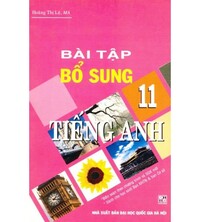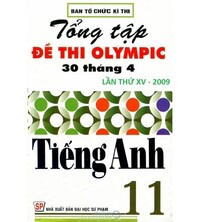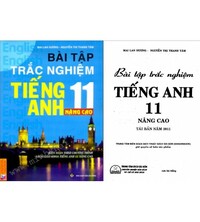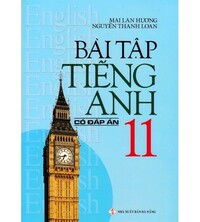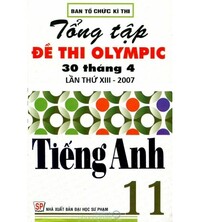Tiếng Anh 11 Bright B CLIL
1. Where is the Great Barrier Reef? What problems does it face? Listen/Watch and read to find out. 2. Read the text and decide if each of the statements (1-5) is T (true) or F (false). 3. What do the following numbers in the text in Exercise 1 refer to?4. Read the statements and find one more reason in the text. 5. Use the ideas in Exercise 4 to say why coral reefs are important. Tell the class.
Bài 1
1. Where is the Great Barrier Reef? What problems does it face? Listen/Watch and read to find out.
(Rạn san hô Great Barrier ở đâu? Nó phải đối mặt với những vấn đề gì? Nghe/Xem và đọc để tìm hiểu.)
PROTECTING THE GREAT BARRIER REEF
There is a good reason why it is called 'Great'. The Great Barrier Reef, along the northeast coast of Australia, is the world's largest coral reef system. It is so large that we can even see it from space! With over 348 square kilometres in size, the Great Barrier Reef is one of the most different ecosystems on Earth. It is home to 1,500 species of fish and 4,000 shellfish as well as 30 species of marine animals such as whales, dolphins and sea turtles. The reef contains 400 types of coral and more than 2,500 separate coral reefs.
The Great Barrier Reef is a natural wonder and has been a World Heritage area since 1981 because of its global scientific and environmental importance. Besides its incredible ecosystem, the Great Barrier Reef is an important part of the Earth's natural history and an area of amazing natural beauty. Sadly, though, since 1985, the Great Barrier Reef has lost more than 50% of its coral, mostly because of global warming. As the Earth becomes warmer, ocean water temperatures increase and cause coral bleaching. This is when coral turns white and dies. The world must reduce CO₂ emissions in order to stop the coral from dying. Pollution, tourism and overfishing are also threatening the coral reef.
The good news is that 99% of the reef is now a marine park that protects the coral by controlling tourism, fishing and leisure activities in the park. The park organisation works hard to improve the quality of water, cool the area of the reef and reduce natural threats to the coral.
Phương pháp giải:
Tạm dịch:
BẢO VỆ RẠN SAN HÔ GREAT BARRIER
Có một lý do chính đáng tại sao nó được gọi là “Lớn”. Rạn san hô Great Barrier, dọc theo bờ biển phía đông bắc Australia, là hệ thống rạn san hô lớn nhất thế giới. Nó lớn đến mức chúng ta thậm chí có thể nhìn thấy nó từ không gian! Với diện tích hơn 348 km2, Rạn san hô Great Barrier là một trong những hệ sinh thái khác biệt nhất trên Trái đất. Đây là nơi sinh sống của 1.500 loài cá và 4.000 loài động vật có vỏ cũng như 30 loài động vật biển như cá voi, cá heo và rùa biển. Rạn san hô chứa 400 loại san hô và hơn 2.500 rạn san hô riêng biệt.
Rạn san hô Great Barrier là một kỳ quan thiên nhiên và là khu vực Di sản Thế giới từ năm 1981 bởi vì tầm quan trọng về khoa học và môi trường toàn cầu của nó. Bên cạnh hệ sinh thái đáng kinh ngạc của nó, Rạn san hô Great Barrier là một phần quan trọng trong lịch sử tự nhiên của Trái đất và là một khu vực có vẻ đẹp tự nhiên tuyệt vời. Tuy nhiên, đáng buồn là kể từ năm 1985, Rạn san hô Great Barrier đã mất hơn 50% san hô, chủ yếu là do sự nóng lên toàn cầu. Khi Trái đất trở nên ấm hơn, nhiệt độ nước biển tăng lên và gây ra hiện tượng tẩy trắng san hô. Đây là lúc san hô chuyển sang màu trắng và chết. Thế giới phải giảm lượng khí thải CO₂ để ngăn san hô chết. Ô nhiễm, du lịch và đánh bắt quá mức cũng đang đe dọa rạn san hô.
Tin tốt là 99% rạn san hô hiện là công viên biển bảo vệ san hô bằng cách kiểm soát các hoạt động du lịch, câu cá và giải trí trong công viên. Tổ chức công viên làm việc chăm chỉ để cải thiện chất lượng nước, làm mát khu vực rạn san hô và giảm các mối đe dọa tự nhiên đối với san hô.
Lời giải chi tiết:
The Great Barrier Reef is along the northeast coast of Australia. Since 1985, it has lost more than 50% of its coral, mostly because of global warming.
(Rạn san hô Great Barrier nằm dọc theo bờ biển phía đông bắc Australia. Kể từ năm 1985, nó đã mất hơn 50% san hô, chủ yếu là do sự nóng lên toàn cầu.)
Bài 2
2. Read the text and decide if each of the statements (1-5) is T (true) or F (false).
(Đọc văn bản và quyết định xem mỗi câu (1-5) là T (đúng) hay F (sai).)
1. Whales are the only marine animals in the Great Barrier Reef.
2. There are many different corals in the Great Barrier Reef.
3. There was twice as much coral in the reef in 1985 as there is now.
4. The main cause of coral bleaching is pollution.
5. The Great Barrier Reef has become a protected marine park.
Lời giải chi tiết:
|
1. F |
2. T |
3. F |
4. F |
5. T |
1. F
Whales are the only marine animals in the Great Barrier Reef.
(Cá voi là loài động vật biển duy nhất ở Rạn san hô Great Barrier.)
Thông tin: It is home to 1,500 species of fish and 4,000 shellfish as well as 30 species of marine animals such as whales, dolphins and sea turtles. The reef contains 400 types of coral and more than 2,500 separate coral reefs.
(Đây là nơi sinh sống của 1.500 loài cá và 4.000 loài động vật có vỏ cũng như 30 loài động vật biển như cá voi, cá heo và rùa biển. Rạn san hô chứa 400 loại san hô và hơn 2.500 rạn san hô riêng biệt.)
2. T
There are many different corals in the Great Barrier Reef.
(Có nhiều loại san hô khác nhau ở Rạn san hô Great Barrier.)
Thông tin: The reef contains 400 types of coral and more than 2,500 separate coral reefs.
(Rạn san hô chứa 400 loại san hô và hơn 2.500 rạn san hô riêng biệt.)
3. F
There was twice as much coral in the reef in 1985 as there is now.
(Có gấp đôi số lượng san hô trong rạn san hô vào năm 1985 so với hiện tại.)
Thông tin: Sadly, though, since 1985, the Great Barrier Reef has lost more than 50% of its coral, mostly because of global warming.
(Tuy nhiên, đáng buồn là kể từ năm 1985, Rạn san hô Great Barrier đã mất hơn 50% san hô, chủ yếu là do sự nóng lên toàn cầu.)
4. F
The main cause of coral bleaching is pollution.
(Nguyên nhân chính của hiện tượng tẩy trắng san hô là do ô nhiễm.)
Thông tin: As the Earth becomes warmer, ocean water temperatures increase and cause coral bleaching.
(Khi Trái đất trở nên ấm hơn, nhiệt độ nước biển tăng lên và gây ra hiện tượng tẩy trắng san hô.)
5. T
The Great Barrier Reef has become a protected marine park.
(Rạn san hô Great Barrier đã trở thành một công viên biển được bảo vệ.)
Thông tin: The good news is that 99% of the reef is now a marine park that protects the coral by controlling tourism, fishing and leisure activities in the park.
(Tin tốt là 99% rạn san hô hiện là công viên biển bảo vệ san hô bằng cách kiểm soát các hoạt động du lịch, câu cá và giải trí trong công viên.)
Bài 3
3. What do the following numbers in the text in Exercise 1 refer to?
(Các số sau trong đoạn văn ở bài tập 1 nói lên điều gì?)
|
• 50 |
• 99 |
• 30 |
|
• 1,500 |
• 348 |
• 4,000 |
|
• 2,500 |
• 400 |
• 1981 |
Lời giải chi tiết:
- 50 refers to the percentage of coral that the Great Barrier Reef has lost since 1985.
(50 là tỷ lệ phần trăm san hô mà Great Barrier Reef đã mất kể từ năm 1985.)
- 99 refers to the percentage of the Great Barrier Reef that is now a marine park.
(99 đề cập đến tỷ lệ rạn san hô Great Barrier hiện là công viên biển.)
- 30 refers to the number of species of marine animals found in the Great Barrier Reef.
(30 là số loài động vật biển được tìm thấy ở Rạn san hô Great Barrier.)
- 1,500 refers to the number of fish species found in the Great Barrier Reef.
(1.500 là số loài cá được tìm thấy ở Rạn san hô Great Barrier.)
- 348 refers to the size of the Great Barrier Reef in square kilometers.
(348 là kích thước của Rạn san hô Great Barrier tính bằng kilômét vuông.)
- 4,000 refers to the number of shellfish species found in the Great Barrier Reef.
(4.000 là số loài động vật có vỏ được tìm thấy ở Rạn san hô Great Barrier.)
- 2,500 refers to the number of separate coral reefs that make up the Great Barrier Reef.
(2.500 là số lượng rạn san hô riêng biệt tạo nên Rạn san hô Great Barrier.)
- 400 refers to the number of coral types found in the Great Barrier Reef.
(400 là số lượng các loại san hô được tìm thấy ở Rạn san hô Great Barrier.)
- 1981 refers to the year the Great Barrier Reef was declared a World Heritage area.
(Năm 1981 là năm Rạn san hô Great Barrier được tuyên bố là khu vực Di sản Thế giới.)
Bài 4
4. Read the statements and find one more reason in the text.
(Đọc các câu phát biểu và tìm thêm một lý do trong văn bản.)
The Great Barrier Reef is a World Heritage area because it...
1. is home to different marine species.
2. is of global scientific and environmental importance.
3. is an incredible ecosystem.
4. is an important part of the Earth's natural history.
5. _________________________________________
Lời giải chi tiết:
The Great Barrier Reef is a World Heritage area because it...
(Rạn san hô Great Barrier là một khu vực Di sản Thế giới vì nó...)
1. is home to different marine species.
(là nơi sinh sống của các loài sinh vật biển khác nhau.)
2. is of global scientific and environmental importance.
(có tầm quan trọng về khoa học và môi trường toàn cầu.)
3. is an incredible ecosystem.
(là một hệ sinh thái đáng kinh ngạc.)
4. is an important part of the Earth's natural history.
(là một phần quan trọng trong lịch sử tự nhiên của Trái Đất.)
5. is now a protected marine park.
(bây giờ là một công viên biển được bảo vệ.)
Bài 5
5. Use the ideas in Exercise 4 to say why coral reefs are important. Tell the class.
(Sử dụng những ý tưởng trong Bài tập 4 để nói tại sao các rạn san hô lại quan trọng. Nói với lớp.)
Lời giải chi tiết:
Coral reefs, such as the Great Barrier Reef, are incredibly important for a variety of reasons. Firstly, they are home to a wide range of marine species. These species rely on the coral reefs for food, shelter and breeding grounds. Secondly, coral reefs are of global scientific and environmental importance, as they are incredibly diverse and provide a natural laboratory for scientists to study. They are also an important indicator of the health of the world's oceans. Besides, coral reefs are an incredible ecosystem, with a delicate balance between the different species that inhabit them. Finally, the protection of coral reefs is vital for the preservation of the Earth's natural history and amazing natural beauty.
Tạm dịch:
Các rạn san hô, chẳng hạn như Rạn san hô Great Barrier, cực kỳ quan trọng vì nhiều lý do. Thứ nhất, chúng là nơi sinh sống của nhiều loài sinh vật biển. Những loài này dựa vào các rạn san hô để tìm thức ăn, nơi trú ẩn và nơi sinh sản. Thứ hai, các rạn san hô có tầm quan trọng về mặt khoa học và môi trường toàn cầu, vì chúng vô cùng đa dạng và cung cấp một phòng thí nghiệm tự nhiên cho các nhà khoa học nghiên cứu. Chúng cũng là một chỉ số quan trọng về sức khỏe của các đại dương trên thế giới. Bên cạnh đó, các rạn san hô là một hệ sinh thái đáng kinh ngạc, với sự cân bằng tinh tế giữa các loài khác nhau sinh sống ở đó. Cuối cùng, việc bảo vệ các rạn san hô là rất quan trọng để bảo tồn lịch sử tự nhiên của Trái đất và vẻ đẹp tự nhiên tuyệt vời.
Bài 6
Project
6. Think of a natural feature in your country that is under threat. Collect information under the headings name, its importance, the threats it faces and actions to protect it.
(Hãy nghĩ về một đặc điểm tự nhiên ở đất nước của bạn đang bị đe dọa. Thu thập thông tin dưới tên tiêu đề, tầm quan trọng, các mối đe dọa mà nó phải đối mặt và các hành động để bảo vệ nó.)
Lời giải chi tiết:
Name: The Amazon Rainforest
Its importance:
The Amazon Rainforest is the largest tropical rainforest in the world, covering over 5.5 million square kilometers in South America. It is also known as the "lungs of the Earth" because it produces 20% of the world's oxygen. The rainforest is also a vital resource for indigenous communities, providing food, shelter, and natural medicine.
The threats it faces:
The Amazon Rainforest faces several threats, including deforestation, mining, agriculture, and climate change. Deforestation is the primary threat to the rainforest, as large areas of forest are being cleared for farming. Mining operations also destroy vast areas of the forest, affecting human health. Climate change is causing forest fires in the Amazon, leading to further deforestation and loss of biodiversity.
Actions to protect it:
There are several actions being taken to protect the Amazon Rainforest, such as increasing enforcement of laws against illegal mining, and creating protected areas for wildlife. International organizations are also working to reduce demand for products linked to deforestation. In addition, individuals can reduce their consumption of products, support conservation organizations, and raise awareness about the importance of protecting the Amazon Rainforest.
Tạm dịch:
Tên: Rừng nhiệt đới Amazon
Tầm quan trọng của nó:
Rừng mưa nhiệt đới Amazon là rừng mưa nhiệt đới lớn nhất thế giới, có diện tích hơn 5,5 triệu km2 ở Nam Mỹ. Nó còn được gọi là "lá phổi của Trái đất" vì nó tạo ra 20% lượng oxy của thế giới. Rừng nhiệt đới cũng là một nguồn tài nguyên quan trọng cho các cộng đồng bản địa, cung cấp thực phẩm, nơi trú ẩn và thuốc tự nhiên.
Các mối đe dọa mà nó phải đối mặt:
Rừng nhiệt đới Amazon phải đối mặt với một số mối đe dọa, bao gồm nạn phá rừng, khai thác mỏ, nông nghiệp và biến đổi khí hậu. Phá rừng là mối đe dọa chính đối với rừng mưa nhiệt đới, vì những khu vực rừng rộng lớn đang bị chặt phá để canh tác. Hoạt động khai thác cũng phá hủy các khu vực rộng lớn của rừng, ảnh hưởng đến sức khỏe con người. Biến đổi khí hậu đang gây ra cháy rừng ở Amazon, dẫn đến nạn phá rừng và mất đa dạng sinh học.
Các hành động để bảo vệ nó:
Có một số hành động đang được thực hiện để bảo vệ Rừng nhiệt đới Amazon, chẳng hạn như tăng cường thực thi luật chống khai thác trái phép và tạo ra các khu vực được bảo vệ cho động vật hoang dã. Các tổ chức quốc tế cũng đang làm việc để giảm nhu cầu đối với các sản phẩm liên quan đến nạn phá rừng. Ngoài ra, các cá nhân có thể giảm tiêu thụ sản phẩm, hỗ trợ các tổ chức bảo tồn và nâng cao nhận thức về tầm quan trọng của việc bảo vệ Rừng nhiệt đới Amazon.
Search google: "từ khóa + timdapan.com" Ví dụ: "Tiếng Anh 11 Bright B CLIL timdapan.com"
